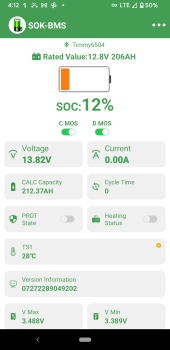Hedges
I See Electromagnetic Fields!
- Joined
- Mar 28, 2020
- Messages
- 20,701
Yes, correct, but you don't have enough digits difference between 3.157V and 3.155V to get much precision.
Maybe 3.157 is really closer to 3.158, maybe closer to 3.156
Maybe 3.155 is closer to 3.154, maybe 3.156
So that could be (3.156 - 3.156)V / 0.62A = zero ohms,
or (3.157 - 3.154)V = 0.0064 ohms
I'm looking for a figure in the range 0.00025 ohms, typical for LiFePO4 cells.
If you used the following DMM, could get more digits resolution of voltage.

 www.keysight.com
www.keysight.com
Otherwise, load your inverter with about 2500W so you draw 100A from battery. Use system measurement of current draw if available, unless you have a clamp ammeter.
Higher current will give more digits resolution on your volt meter.

 www.harborfreight.com
www.harborfreight.com
Accuracy of a meter is usually quoted as a percentage of reading plus a number of counts in the last digit.
Taking relative measurements like your two voltages helps reduce the error.
We like to have 10 counts better resolution that what we're trying to quote, at least 4 counts.
Maybe 3.157 is really closer to 3.158, maybe closer to 3.156
Maybe 3.155 is closer to 3.154, maybe 3.156
So that could be (3.156 - 3.156)V / 0.62A = zero ohms,
or (3.157 - 3.154)V = 0.0064 ohms
I'm looking for a figure in the range 0.00025 ohms, typical for LiFePO4 cells.
If you used the following DMM, could get more digits resolution of voltage.

3458A Digital Multimeter, 8.5 Digit
Keysight's 3458A is a fast, flexible, and accurate 8.5-digit multimeter. With a system or on the bench, the 3458A digital multimeter offers low cost of ownership.
Otherwise, load your inverter with about 2500W so you draw 100A from battery. Use system measurement of current draw if available, unless you have a clamp ammeter.
Higher current will give more digits resolution on your volt meter.

CM1000A 1000A T-RMS AC/DC Clamp Meter
Amazing deals on this 1000A T-Rms Ac/Dc Clamp Meter at Harbor Freight. Quality tools & low prices.
Accuracy of a meter is usually quoted as a percentage of reading plus a number of counts in the last digit.
Taking relative measurements like your two voltages helps reduce the error.
We like to have 10 counts better resolution that what we're trying to quote, at least 4 counts.




